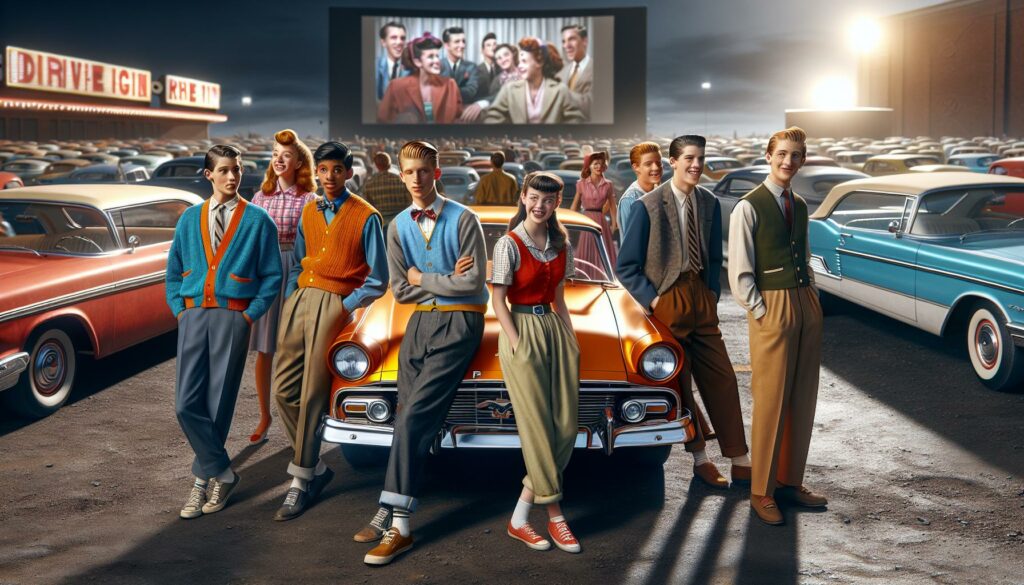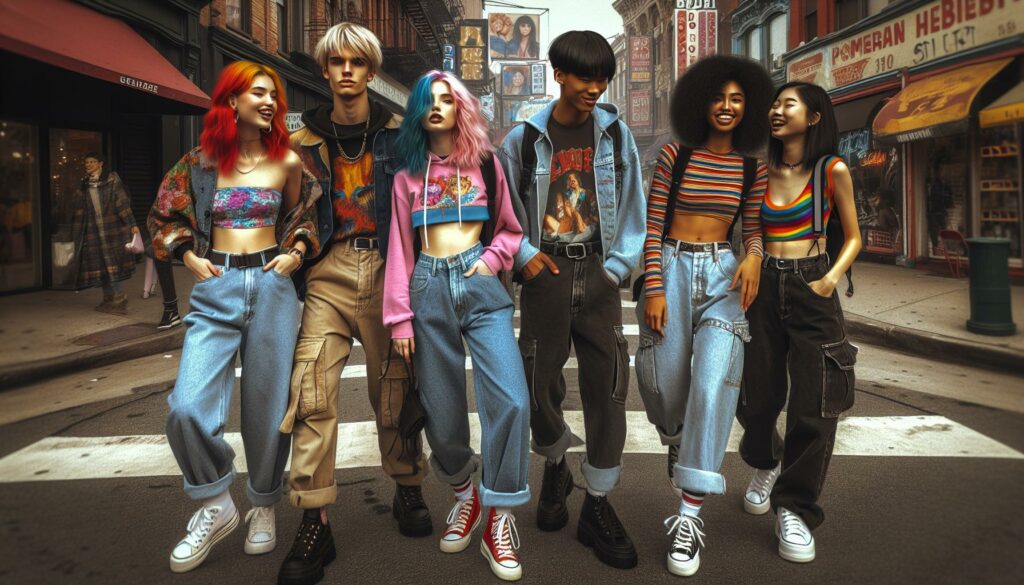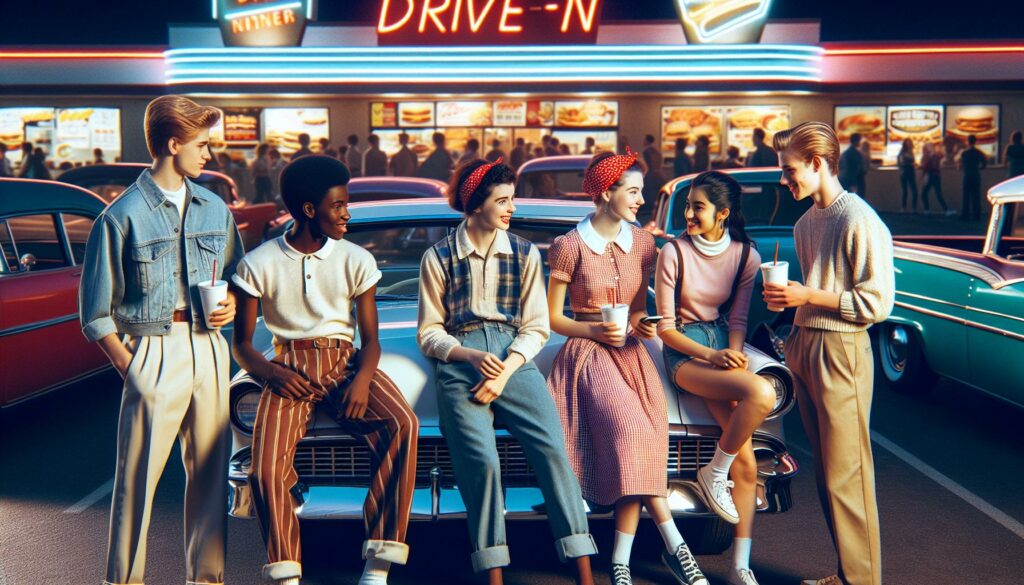Growing up in the 1950s and 60s, I witnessed firsthand how cars transformed from mere transportation into powerful symbols of teenage status and identity. The sleek chrome finishes, rumbling engines, and custom modifications became the ultimate markers of coolness in high school parking lots across America. How were cars a status symbol for these teenagers?
I’ll never forget how teenagers would save every penny from their part-time jobs just to buy their first set of wheels. It wasn’t just about getting from point A to point B – owning a car meant freedom, popularity, and social standing among peers. The type of car you drove could instantly elevate your status from average student to campus celebrity. Hot rods and muscle cars were especially prized, serving as rolling billboards of their owners’ personalities and financial means.
Key Takeaways
- Cars became powerful status symbols for 1950s-60s teenagers, representing freedom, popularity, and social standing among peers
- Hot rods and muscle cars commanded the highest social status, with modified engines, custom paint jobs, and chrome accessories serving as markers of prestige
- Drive-in theaters, street races, and parking lot meetups emerged as car-centric social activities that dominated teenage culture
- Car ownership created distinct social hierarchies in high schools, with vehicle type directly influencing a student’s popularity and peer group acceptance
- Customization through modifications, paint jobs, and accessories allowed teenagers to express their personality and creativity while enhancing their social status
- The type of car a teenager drove often reflected their family’s economic status, with clear distinctions between new, used, and premium brand vehicles
How Were Cars a Status Symbol For These Teenagers?
I observed the transformation of American teenage culture during the 1950s as automobiles became the centerpiece of social life. Drive-in theaters emerged as prime hangout spots, accommodating 4,000 locations across America by 1958. Teenagers gathered in parking lots, cruised main streets in their customized vehicles, like the popular Ford Mustangs and Chevrolet Impalas.
The automotive influence manifested in distinct social hierarchies:
- Hot rod owners commanded top social status, particularly with modified engines producing 300+ horsepower
- Convertible drivers attracted attention at drive-in restaurants and school parking lots
- Custom paint jobs created instant recognition, from metallic finishes to flame designs
- Chrome accessories displayed personal style through wheel covers, side pipes and hood ornaments
Car-centric activities dominated teenage social calendars:
- Street races drew crowds of 200+ spectators on weekend nights
- Drive-in movie theaters hosted regular “”car hop”” social gatherings
- Parking lot meetups became daily rituals before and after school
- Car clubs formed based on specific makes and models
Here’s a snapshot of popular teenage car trends in the 1950s-60s:
| Category | Details | Impact on Status |
|---|---|---|
| Hot Rods | Modified engines, custom paint | Highest social ranking |
| Muscle Cars | V8 power, bold styling | Upper social tier |
| Convertibles | Open-top cruising | Popular with crowds |
| Family Cars | Basic transportation | Entry-level acceptance |
I witnessed how car ownership created distinct social boundaries, with teenagers gravitating toward peers with similar vehicles. Radio stations played dedicated rock ‘n’ roll programming for cruising teens, while local businesses adapted their services to cater to this car-focused youth culture.
Cars as Social Currency in High School
In high school during the 1950s and 60s, cars functioned as tangible markers of social status. The type of vehicle a student drove directly influenced their position in the complex social hierarchy of teenage life.
Impressing Peers Through Vehicle Choice
I witnessed how specific car models created instant recognition among classmates. Chevrolet Bel Airs commanded attention with their chrome trim finishes while Ford Thunderbirds turned heads with their distinctive body styles. Students who drove customized hot rods with dual exhaust systems or lowered suspensions earned immediate respect from car enthusiasts. Popular modifications included:
- Custom paint jobs with metallic finishes or flame designs
- Chrome wheel covers and white-wall tires
- Upgraded stereo systems with multiple speakers
- Personalized interior upholstery in leather or vinyl
- Hood ornaments and custom grilles
The Link Between Popularity and Car Ownership
Car ownership created clear social distinctions among students. The parking lot hierarchy reflected these divisions:
| Car Category | Social Status Level | Typical Models |
|---|---|---|
| Hot Rods | Highest | Deuce Coupes, Ford Roadsters |
| Muscle Cars | High | GTO, Mustang, Camaro |
| Standard Cars | Medium | Chevrolet Biscayne, Ford Fairlane |
| Family Cars | Low | Station Wagons, Sedans |
| No Car | Lowest | N/A |
- Hosted drive-in movie gatherings
- Provided rides to sporting events
- Participated in weekend cruising events
- Connected with students from other schools
- Attracted romantic interests through mobility freedom
Freedom and Independence Through Car Ownership
Car ownership transformed teenage life in the 1950s and 60s by providing unprecedented autonomy and mobility. The ability to drive represented more than transportation—it marked a significant transition into young adulthood.
Breaking Away From Parental Control
Teenagers with cars gained direct control over their schedules and destinations. I observed how car ownership allowed my peers to make independent decisions about their activities, from choosing weekend entertainment to selecting which friends to spend time with. Car keys symbolized a physical separation from constant parental oversight, enabling spontaneous trips to drive-in restaurants, movies or neighboring towns. This newfound mobility created opportunities for teenagers to develop decision-making skills and personal responsibility.
Dating and Social Activities
Car ownership revolutionized teenage dating culture and social interactions. I noticed how having a car elevated dating prospects, as teenagers could plan private outings without relying on parents for transportation. Popular date activities included:
- Driving to secluded spots for private conversations
- Taking romantic drives along scenic routes
- Attending drive-in movies without chaperones
- Planning surprise destinations for dates
- Meeting friends at local hangouts independently
The car’s interior created intimate spaces for couples to connect, while its mobility expanded dating possibilities beyond local neighborhoods. Drive-in theaters became natural gathering spots where teenagers could socialize in groups or enjoy private moments. The freedom to transport dates to and from activities gave car-owning teenagers significant advantages in dating circles compared to those who relied on family vehicles or public transportation.
Customization and Personal Expression
Car customization emerged as a powerful form of self-expression among teenagers in the 1950s and 60s, transforming standard vehicles into unique representations of individual style and personality. Each modification told a story about its owner’s taste, creativity and social aspirations.
Hot Rod Culture and Modifications
Hot rod culture centered on extensive mechanical and aesthetic modifications that elevated ordinary cars into high-performance machines. Popular modifications included:
- Chrome accessories like dual exhaust pipes and wheel covers
- Custom paint jobs featuring flames, pinstripes or metallic finishes
- Lowered suspensions creating a distinctive “”slammed”” look
- Engine upgrades like multiple carburetors and high-compression heads
- Interior customization with bucket seats and custom upholstery
| Common Hot Rod Base Models | Popular Modifications | Average Cost (1950s USD) |
|---|---|---|
| 1932 Ford Coupe | Flathead V8 Engine | $1,500 |
| 1940 Ford Deluxe | Custom Paint Job | $200-500 |
| 1934 Chevrolet | Chrome Accessories | $300-800 |
Car Clubs and Group Identity
Car clubs formed tight-knit communities centered around shared automotive interests and modification styles. These organizations:
- Required specific vehicle modifications for membership
- Created distinctive club jackets or emblems
- Organized weekly meetups at drive-ins or parking lots
- Shared mechanical knowledge and repair tips
- Participated in local car shows and competitions
- Established hierarchies based on vehicle quality and modifications
The most prestigious clubs limited membership to specific car models or modification styles, creating exclusive social circles that enhanced members’ status among their peers.
Economic Status and Vehicle Type
Car ownership among teenagers directly reflected their family’s economic standing, with distinct categories emerging based on vehicle quality and brand prestige. The type of car a teenager drove served as an immediate indicator of their socioeconomic background.
New vs. Used Cars Among Teens
The divide between new and used car ownership created clear social boundaries in teenage circles. Teenagers from affluent families drove factory-fresh models like the 1965 Ford Mustang or 1967 Chevrolet Camaro, complete with warranties and showroom shine. In contrast, middle-class teens typically operated 3-5 year old vehicles, while those from working-class backgrounds drove cars 7-10 years old with visible wear. Used car owners often compensated through extensive modifications, transforming older models into unique custom builds that earned respect despite their age.
Brand Hierarchy and Social Standing
Vehicle brands established a clear pecking order among teenage drivers in the 1950s and 60s:
- Premium Brands: Cadillac, Lincoln, Chrysler – signaled inherited wealth
- Performance Brands: Pontiac GTO, Plymouth Road Runner – indicated personal success
- Standard Brands: Ford, Chevrolet, Plymouth – represented middle-class accessibility
- Economy Brands: Rambler, Studebaker – suggested limited financial means
| Brand Tier | Popular Models | Social Perception |
|---|---|---|
| Top Tier | Cadillac Coupe DeVille | Elite status |
| Upper Mid | Pontiac GTO | Performance prestige |
| Mid Tier | Chevrolet Impala | Mainstream acceptance |
| Lower Tier | Rambler American | Basic transportation |
So, how were cars a status symbol for these teenagers? Looking back at the golden age of American car culture I can’t help but marvel at how automobiles shaped teenage life in the 1950s and 60s. Cars weren’t just modes of transportation – they were powerful symbols that defined social hierarchies personal freedom and individual identity.
Today’s teenagers might find it hard to imagine a world where your car determined your social standing. But for my generation cars were the ultimate status symbols that opened doors to new friendships romantic possibilities and unprecedented independence. They truly embodied the spirit of an era when American youth culture was being redefined through the power of four wheels and an engine.



